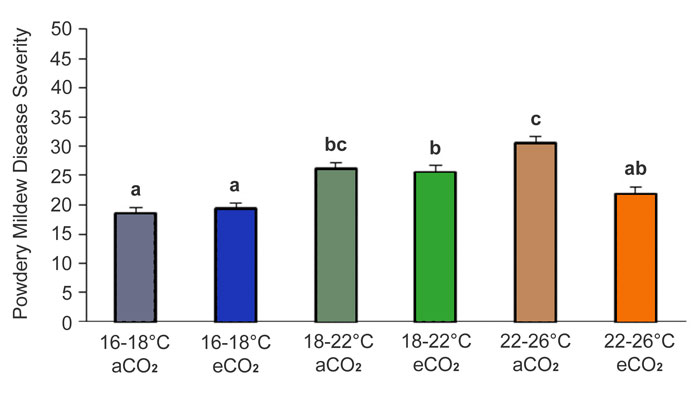| Tweet | Follow @co2science |
Paper Reviewed
Gullino, M.L., Tabone, G., Gilardi, G. and Garibaldi, A. 2020. Effects of elevated atmospheric CO2 and temperature on the management of powdery mildew of zucchini. Journal of Phytopathology, DOI: 10.1111/jph.12905.
Some have expressed concerns that future changes in global climate will affect the incidence and severity of plant diseases, potentially altering (reducing) crop yields and burdening the agricultural industry. Gullino et al. (2020) recently looked into this subject in a paper published in the Journal of Phytopathology, where they examined "the effects of possible future climate change scenarios on the efficacy of [disease] management strategies based on alternative products against the powdery mildew of zucchini, compared to conventional strategies based on Sulphur."
Powdery mildew diseases is incited by Podosphaera xanthii, a severe cucurbit disease common throughout the globe. It is presently controlled by biological agents and natural compounds. To investigate the response of different strategies to control powdery mildew under potential climate change, Gullino et al. exposed zucchini (Cucurbita pepo) plants to two atmospheric CO2 concentrations (approximately 425 or 825 ppm) and three temperature (16-18°C, 18-22°C, or 22-26°C) regimes in controlled-environment phytotrons. Two days after exposure to the various treatment conditions, they began employing five different disease management strategies prior to and/or after P. xanthii inoculation based on normal recommended practices for each approach. The management strategies included the application of (1) a biocontrol agent (Ampelomyces quisqualis, a mycoparasite), (2) Sulphur, (3) calcium oxide, (4) potassium silicate, or (5) potassium phosphite. Following such application, the researchers observed and analyzed disease development and severity.
Results of the analysis showed that higher temperatures tended to increase disease severity. However, Gullino et al. report the interaction between higher temperatures and elevated CO2 concentrations "systematically yielded lower powdery mildew incidence. Indeed, as shown in the figure below, disease incidence in the 22-26°C temperature treatment under ambient CO2 is significantly higher than the low temperature treatment (16-18°C; under ambient or elevated CO2). However, when combined with elevated CO2, the disease incidence in the 22-26°C temperature treatment is no different than that observed in the 16-18°C temperature treatments and no different (e.g., at ambient CO2) or lower (e.g., at elevated CO2) than that observed in the 18-22°C temperature treatments. Gullino et al. also observed that Sulphur was the most effective control on powdery mildew disease among the five management studies examined, reducing the efficacy of the disease by 75-85%. Calcium oxide was the second most effective treatment with an efficacy ranging from 46-61% depending on treatment conditions. More important to note, however, was the observation that "the interaction between temperature, treatments and CO2 concentrations did not influence the disease control provided by the [five] tested [management] products."
In light of all of the above Gullino et al. conclude "the results of this study show that the efficacy of different control measures tested in the zucchini-P. xanthii pathosystem was not affected by the considered changes in temperature and carbon dioxide." And we suggest this positive conclusion may well be conservative, for the plants in Gullino et al.'s study were only exposed to elevated CO2 for a handful of days before being inoculated with P. xanthii. Were they allowed to grow and experience CO2 enrichment across the full life cycle, the plants could have taken better advantage of the growth-enhancing and water-conserving impacts common at higher CO2 levels, which often induce important physiological changes (e.g., stomatal reductions) and enhance the production of key defensive compounds (e.g., salicylic acid, jasmonic acid) that help reduce disease incidence and severity. Many examples of such CO2-induced benefits can be found in other papers we have reviewed on this topic and archived in our Subject Index under the heading Disease (Plants) on this page.

Figure 1. Impact of different temperatures (16-18°C, 18-22°C and 22-26°C) and CO2 concentrations (aCO2 = ~425 ppm; eCO2 = ~825 ppm) on the severity of powdery mildew disease on zucchini. Values with the same letter are not significantly different, according to Tukey's Test (p < .05). The data are expressed as the average disease severity at the end of the trials (means of five trials ± standard error). The calculation of disease severity is explained in the author's original text. Adapted from Gullino et al. (2020).




